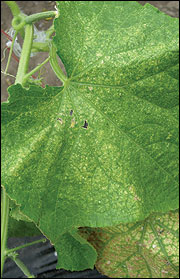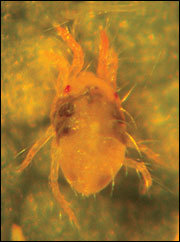Spider mites
Spider mites are small (1/50 inch long), oval-shaped arthropods related to spiders. The most common spider mite on high tunnel melons and watermelons is the two-spotted spider mite (Tetranychus urticae) with two dark spots on the abdomen (Figure 21). Mites can be found on the underside of leaves where they congregate and suck sap from the plant. The leaf surface develops a scratch-like, "strippled" appearance and interveinal yellowing or bronzing develops (Figure 21). Eventually the leaves die, and the plant becomes progressively weakened. As the population of mites increases, they develop a webbing around the area where they feed and lay eggs. Mites thrive in hot, dry climates (at least 80 degrees Fahrenheit and less than 50 percent relative humidity) and thus become a problem on high tunnel melons and watermelons from midseason onward in the Midwest.
The two-spotted spider mite overwinters in the Midwest and will infest early-season melons in a high tunnel if all weeds and other residue are not removed before establishing the melon or watermelon crop. Clean mowing of vegetation around the high tunnel will reduce the risk of spider mite movement into the high tunnel. Exclusion screening will prevent or reduce spider mite invasion. Spider mites have several natural enemies. Miticides can be used to control the two-spotted spider mite. Most miticides will not kill mite eggs, so the first and second spray application should be relatively close together to kill nymphs and adults, which hatch from eggs laid earlier. Always read the label of the pesticide before application. Surfactants should be used to improve miticide distribution over the crop canopy.

